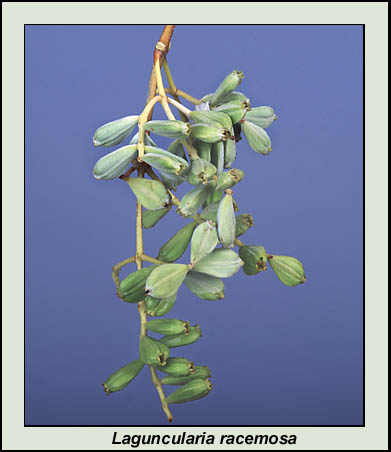White Mangrove
Laguncularia racemosa
Family: Combretaceae
Natural History

The white mangrove is one of four mangrove species in the mangrove community. The other species are the red mangrove (Rhizophoria mangle), black mangrove (Avicennia germinans), and buttonwood (Conocarpus erectus). Scientifically, they are distantly related and are only grouped based on ecological function within the community.
White mangroves range from Volusia County and Levy County southward. The mangrove community plays an important role in the tropical and subtropical regions of the world. Different mangrove species protect and stabilize low lying coastal lands and provide protection and food sources for estuarine and coastal fishery food chains.
Mangroves serve as feeding, breeding, and nursery grounds for a variety of fish, shellfish, birds, and other wildlife. Mangroves also produce 3.6 tons per acre of leaf litter per year, which benefit estuarine food chains. An estimated 75% of the game fish and 90% of the commercial species in south Florida depend on the mangrove system.
The white mangrove is easily differentiated from other mangrove species by its leaves and root system. The leaves are rounded at the base and the tip and are smooth underneath. Each leaf has two glands, called nectarines, at its base that excrete sugar. Many insects feed on the excreted sugar.
Depending on habitat conditions, the white mangrove may possess pneumataphores and/or proproots. Pneumatophores are cone-shaped extensions of the root system protruding from the ground. Pneumatophores are thought to function as the trees' means of obtaining oxygen for the roots during flooded conditions. Prop roots are tall arching roots originating from trunks and branches. The white mangrove is fast growing in fertile habitats.
A common belief that the mangroves build land is usually not true. However, after they colonize newly formed sandbars and embankments, their roots may entrap and accumulate soil, helping to stabilize soil during rough weather.
